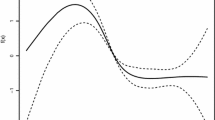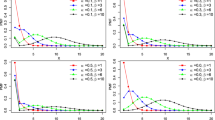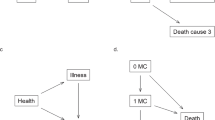Abstract
Two principle approaches to the modelling of competing risks in discrete time are considered. In the first approach which is based on the separation between failure and cause specific response only the causes of failure are considered as ordered. The second approach which is based on the conditional response given interval [a t-1,ar) is reached allows for an ordering of causes of failureand the category ‘no failure’. The latter approach is shown to be more general. It is shown that the considered competing risks models may be estimated within the framework of generalized linear models. A data set concerning duration of unemployment illustrates the approaches.
Similar content being viewed by others
References
Agresti, A. (1984).Analysis of Ordinal Categorical Data. New York: Wiley.
Aranda-Ordaz, F. J. (1982). An extension of proportional-hazard-model for grouped data.Biometrics 39: 100–118.
Berridge, D. M. (1991). Analysis of Failure Time Data with Ordered Categories of Response. Ph.D. thesis, University of Reading (unpublished).
Berridge, D. M. and Whitehead, J. (1991). Analysis of failure time data with ordinal categories of response.Statistics in Medicine 10: 1703–1710.
Cox, D. R. (1972). Regression models and life tables (with discussion).Journal of the Royal Statistical Society B34: 187–220.
Efron, B. (1988). Logistic regression, survival analysis, and the Kaplan-Meier-curve.Journal of the American Statistical Association 83: 414–425.
Fahrmeir, L., Frost, H., Hennevogl, W., Kaufmann, H., Kranert, T., and Tutz, G. (1992a). GLAMOUR User and Example Guide, UniversitÄt Regensburg.
Fahrmeir, L., Hennevogl, W., and Tutz, G. (1992b).Multivariate Statistical Modelling Based on Generalized Linear Models — Cross Sectional and Longitudinal Analysis. New York: Springer (to appear).
Fahrmeir, L. and Kaufmann, H. (1985). Consistency and asymptotic normality of the maximum likelihood estimator in generalized linear models.The Annals of Statistics 13: 342–368.
Hamerle, A. and Tutz, G. (1989).Diskrete Modelle zur Analyse von Verweildauer und Lebenszeiten. Frankfurt/New York: Campus.
Hanefeld, U. (1987).Das sozio-ökonomische Panel. Frankfurt: Campus.
Kalbfleisch, J. and Prentice, R. (1973). Marginal likelihoods based on Cox's regression and life model.Biometrika 60: 256–278.
Kalbfleisch, J. and Prentice, R. (1980).The Statistical Analysis of Failure Time Data. New York: Wiley.
McCullagh, P. (1980). Regression model for ordinal data (with discussion).Journal of the Royal Statistical Society B42, 109–127.
Prentice, R. L. and Gloeckler, L. A. (1978). Regression analysis of grouped survival data with application to breast cancer data.Biometrics 34: 57–67.
Thompson, W. A., Jr. (1977). On the treatment of grouped observations in life studies.Biometrics 33: 463–470.
Tibshirani, R. and Ciampi, A. (1983). A family of proportional- and additive-hazards models for survival data.Biometrics 39: 141–147.
Tutz, G. (1989). Compound regression models for categorical ordinal data.Biometrical Journal 31: 259–272.
Tutz, G. (1991). Sequential models in ordinal regression.Computational Statistics and Data Analysis 11: 275–295.
Tutz, G. and Kranert, T. (1992). Discrete survival models using GLAMOUR.Biometrie und Informatik in Medizin und Biologie 23: 167–184.
Author information
Authors and Affiliations
Rights and permissions
About this article
Cite this article
Tutz, G. Competing risks models in discrete time with nominal or ordinal categories of response. Qual Quant 29, 405–420 (1995). https://doi.org/10.1007/BF01106065
Issue Date:
DOI: https://doi.org/10.1007/BF01106065




